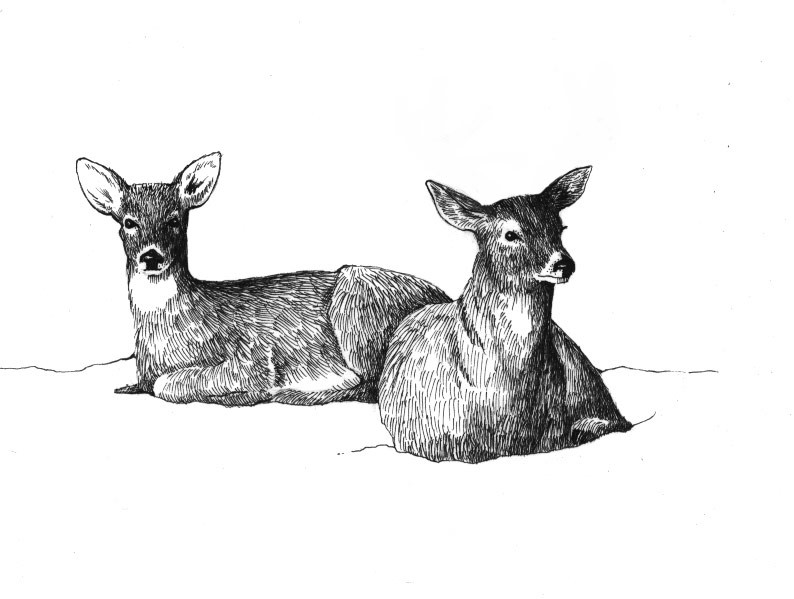
Few of us think about deer at this time of year. There are no fawns to be fawned over, no legal season for hunting, and only rare roadside sightings. Yet for the deer themselves, late winter is the season of desperation.
The whitetail’s strategy for surviving winter is, quite simply, to wait it out. While other animals flee southward, or hibernate in holes, or even freeze solidly (like the wood frog), whitetails hunker down and hope for the best.
Which, this winter, isn’t very good. Heavy snows came early this year and, as of this writing, appear to be here for the duration. What happens to deer under these circumstances? Author Richard Nelson puts it this way in his book, Heart and Blood: Living With Deer in America: “Imagine that 90 percent of our houses become unusable during the coldest and most stressful months, forcing us to crowd into the remaining 10 percent. And to make matters worse, 90 percent of the grocery stores were closed because of snow and other factors, so all of us had to survive on 10 percent of the normal food supply. This is the predicament northern deer face each year.”
The survival strategy of the deer herd includes the certainty that some individuals will starve to death and the hope that not every one will do so. In an open winter, one with little snow cover, the gamble pays off handsomely: fewer than 5 percent of the individuals may die. But in a severe winter like this one, the odds are less favorable: 30 to 50 percent or more of the animals may die in some areas.
The crucial factor for whitetail survival is the 10 percent of the ‘houses’ that remain usable all winter – the specialized habitat known to biologists (and other deer aficionados) as deeryards. Writing in Northern Woodlands magazine, Stephen Long describes a deeryard as, “a thick stand of softwood that is tall enough – at least 35 feet tall – to form a good overhead canopy that provides shelter from the snow and cold. The canopy intercepts snow, which hangs up on branches until it evaporates. The density of the stand creates a barrier to wind, so that the wind-chill factor is less brutal inside than out. In addition, the snow-laden boughs serve almost like a blanket, restricting heat loss into the atmosphere and creating a pocket of warmth for a bedded deer. Within the shelter of a deeryard is a micro-climate that is measurably warmer, less windy, and has considerably less snow.”
The availability of deeryard habitat – not the amount of hunting and predation – is the limiting factor that determines the viability of the deer herd. State wildlife officials, who are entrusted by law with the management of all wild animals, have special land-use designations to help protect the most important deeryards. Local land trusts also help steer human development away from crucial habitat. In general, biologists believe that a deeryard needs to have a minimum of between 50 and 100 acres to be effective in the harshest winters, with roughly three-quarters of the forest cover in mature softwood and the rest in young hardwood and softwood that provide winter browse.
At this time of year, finding deer (or the frozen impressions in the snow where they have bedded down) is a sure-fire indication that you’ve stumbled across a deeryard. Which, if you sympathize at all with the plight of deer, you should avoid doing. If you know where your local deer are yarded up, consider choosing some other place for your late winter outings – why force deer to expend precious energy fleeing from you when there are so many other places available for recreation? And if you happen upon a deeryard accidentally, the best bet is simply to turn around and retrace your steps rather than proceeding ahead and further pushing the deer.
Finally, our beloved dogs pose one of the greatest dangers to deer at this time of year, particularly when there is a crust over the snow that supports wide, soft dog pads but not narrow, sharp whitetail hooves. Canines by nature love to chase deer. A half-starved coyote chasing a half-starved deer with both animals’ lives at stake is one thing; Fido out for a romp after dinner is something else altogether.
So, keep your dog close to home, yourself out of the deeryards and, most of all, keep the deer in your thoughts as they go through their most brutal season. Before you know it, we’ll soon be catching sight of fawns at the edges of fields all across Vermont and New Hampshire.

